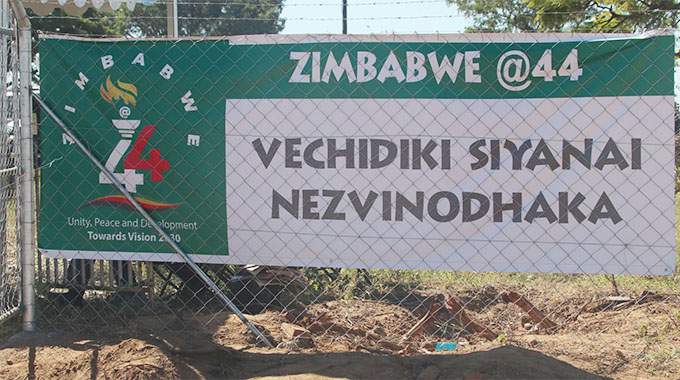Zim TV goes digital

Conrad Mupesa
Mashonaland West Bureau
ZIMBABWE will soon have free-to-air digital television services through 12 stations following the successful and historic switch-over yesterday, from the analogue signal to Digital Terrestrial Television (DTT).
Information, Publicity and Broadcasting Services Minister Monica Mutsvangwa commissioned the country’s digitisation programme under the Zimbabwe Digital Broadcasting Migration at a landmark ceremony in Magunje, Mashonaland West.
The US$125 million migration project to switch over from analogue to digital commenced in 2015 and the nation failed to meet its deadline owing to several setbacks that included poor funding.
At least 18 transmitters, including the Karoi transmitter, have so far been completed from the targeted 48, mostly in areas that had challenges in receiving analogue signals.
Digital terrestrial television (DTT or DTTV) is a technology for terrestrial television in which land-based television stations broadcast television content by radio waves to TV sets in homes in a digital format.
DTT is a major technological advance over the previous analogue television, and has largely replaced analogue which had been in common use since the middle of the 20th century.
Test broadcasts began in 1998 with the changeover to DTT, also known as Analogue Switchoff (ASO) or Digital Switchover (DSO), beginning in 2006 and is now complete in many countries.
The advantages of digital terrestrial television are similar to those obtained by digitising platforms such as cable TV, satellite, and telecommunications: more efficient use of limited radio spectrum bandwidth, provision of more television channels than analogue, better quality images and potentially lower operating costs for broadcasters.
Minister Mutsvangwa launched Zimbabwe’s DTT in the presence of her deputy Kindness Paradza, Minister of State for Mashonaland West Provincial Affairs and Devolution, Mary Mliswa-Chikoka and the Information Ministry’s Permanent Secretary Nick Mangwana.
Zimpapers board chairman Tommy Sithole, chief executive officer Pikirayi Deketeke and senior officials from the Broadcasting Authority of Zimbawe (BAZ), Transmedia and Zimbabwe Broadcasting Corporation (ZBC) also attended the launch.
Minister Mutsvangwa said the migration would help bridge the information gap between urban and rural communities.
The transmitter located near Karoi, will service areas in Hurungwe, Kariba rural, Zvipani, Magunje, Tengwe, Nyamakate, Chidamoyo, Kazangarare and Chundu among others.
“I am pleased to inform you that with the coming in of the Second Republic, the digitisation project in Zimbabwe is now gathering momentum. Since 2015, we have installed 18 digital television transmitters countrywide. The areas prioritised are those that were historically unserved with television services. Karoi is one of the areas.
“Today, we are officially launching the Karoi transmitter, but there are other areas equally earmarked. Of note, we will be launching Chimanimani, a deliberate move by the Second Republic to stimulate the connectivity of that region to the mainstream economy following a series of floods, including Cyclone Idai that had cut off the area from the rest of the country,” she said.
Minister Mutsvangwa reiterated President Mnangagwa’s call for farmers to fully utilise their land to help cut the food import bill so that the government could use the money for the development agenda, including completion of the outstanding 30 transmitters.
She said the National Development Strategy 1 (NDS1) was going to help the nation go digital.
“National Development Strategy 1 is emphasising on funds disbursements, thus if the money is availed, the nation will move from analogue to digital which will in turn help digitise war records and us as the Ministry of Information will use that information to inform and entertain the people.
“My Ministry is grateful to Treasury for the continued support of the project. Commitment from the Central Government is there to complete the project as infrastructure development and technology development is part of Vision 2030.
“Mass media communication, particularly television and radio, is also an integral part of the devolution agenda (and) when used responsibly, radio and television can become tools for discussing the local and national development agendas.”
She urged churches and religious organisations to apply for radio and television station licences as the Government had a robust thrust to decentralise information dissemination, improve freedom of speech; expression and that of choice and association to preserve culture among other benefits.
Minister Mliswa-Chikoka applauded the Second Republic for successfully switching over to digital television and radio signals.
“This is a huge score for our province especially in this devolution era and our provincial Gross Domestic Product (GDP) is set to go up. Our people in marginalised areas and growth points such as Magunje are now enjoying the benefits thereof,” she said.
Minister Mutsvangwa handed over set-top boxes to seven chiefs from Hurungwe district.
A set top box is a gadget that enables an ordinary television user to access DTT signals while users with smart television sets with built-in satellite receivers will only need an antenna to access the signals.







Comments